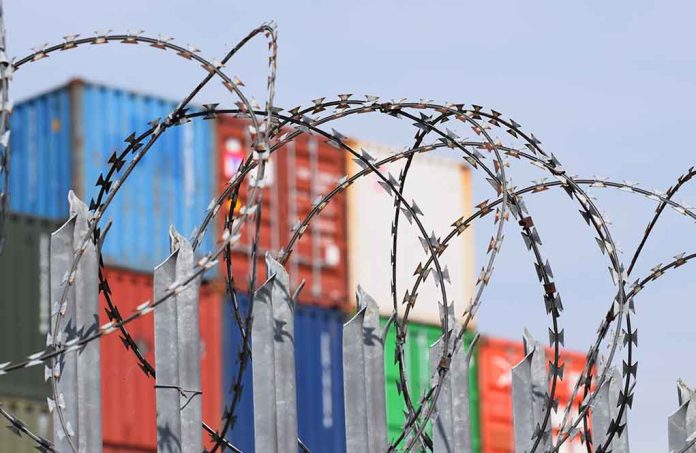
The Port of Los Angeles braces for a steep 35% decline in shipping volume next week as major retailers halt Chinese imports due to Trump’s tariffs, forcing a rapid supply chain restructuring that could soon lead to higher prices and fewer choices for American consumers.
Key Takeaways
- Shipping volume at the Port of Los Angeles is projected to drop by 35% next week as major American retailers cancel shipments from China in response to tariffs.
- Companies are scrambling to source products from Southeast Asia, but these alternatives cannot fully replace the volume lost from China, which represents about 45% of the port’s operations.
- U.S. retailers currently have a 5-7 week inventory buffer due to pre-tariff stockpiling, after which consumers may face higher prices and reduced product selection.
- The shipping slowdown threatens nearly 2 million American jobs in the transportation and retail sectors that depend on port operations, which contributed $300 billion to the economy in 2022.
Major Shipping Decline Signals Trade Policy Impact
The Port of Los Angeles, America’s busiest container port, is bracing for a substantial 35% drop in shipping volume starting next week. This decline stems directly from the current tariff structure, which includes a 145% rate on Chinese goods and a 10% rate on products from nearly all other nations. Port CEO Gene Seroka has indicated that essentially all shipments from China for major retailers and manufacturers have ceased. The impact will be felt widely across the supply chain as Chinese imports represent approximately 45% of the port’s total operations.
The shipping decline isn’t limited to Los Angeles. Similar patterns are emerging at other major U.S. ports as retailers nationwide respond to the tariffs. Data from Wabtec Corp. confirms the slowdown in container volume, with a significant decrease in TEUs (twenty-foot equivalent units) expected in the coming weeks. While a 90-day pause on reciprocal tariffs was announced, excluding China, industry leaders note this provides limited time for businesses to make substantial adjustments to their supply chains.
Shipments from China to drop by 35% next week due to Trump tariffs, Port of LA chief warns https://t.co/UcNXbZBW1D pic.twitter.com/DGXokf17vb
— New York Post (@nypost) April 29, 2025
Retailers Face Tough Choices as Inventories Run Low
Major American retailers currently have about five to seven weeks of inventory stockpiled in their systems. This buffer, created through pre-tariff preparation, will soon be depleted if the current trade policies remain in place. When these inventories are exhausted, retailers will face difficult decisions about whether to absorb higher costs, pass them along to consumers, or reduce product offerings. The situation is particularly challenging given the limited timeframe businesses have to reorganize their procurement and manufacturing strategies.
“It’s my prediction that in two weeks’ time, arrivals will drop by 35% as essentially all shipments out of China for major retailers and manufacturers have ceased, and cargo coming out of Southeast Asia locations is much softer than normal,” said Seroka.
Some companies are attempting to shift their sourcing to Southeast Asian countries to compensate for reduced Chinese shipments. However, these alternative sources cannot quickly or fully replace the manufacturing capacity lost from China. The ripple effects extend beyond American shores, with Seroka noting that “the pain is being felt on both sides of the Pacific.” Chinese manufacturers are losing significant business, while American companies scramble to maintain supply chains amid rapidly changing trade conditions.
Economic Consequences for American Workers and Consumers
The maritime trade industry contributed nearly $300 billion in economic output and supported almost 2 million jobs in 2022. The current slowdown threatens many of these positions, particularly for casual workers at ports who are typically the first to see reduced hours. Truckers, dock workers, and warehouse staff all face potential layoffs if shipping volumes remain depressed. The slowdown is particularly concerning as exports are expected to be even more severely impacted than imports, with retaliatory tariffs affecting agriculture, manufacturing, and IT sectors.
For American consumers, the consequences will soon become apparent on store shelves. The reduced flow of goods is expected to result in fewer product choices and higher prices across multiple retail categories. With the U.S. and China having imposed tariffs exceeding 100% on many goods and no substantial negotiations currently underway, the situation could persist. Economic analysts warn that continued disruption to the import-export relationship could potentially contribute to a broader economic slowdown if solutions aren’t found in the coming weeks and months.









